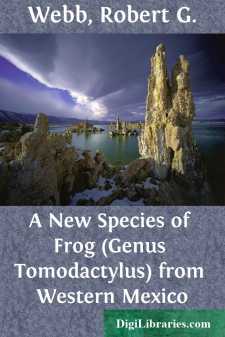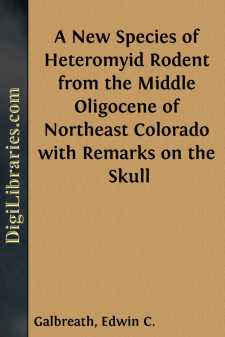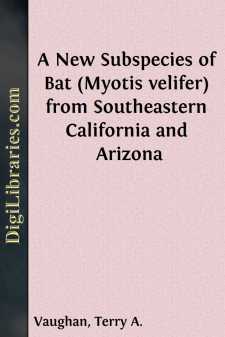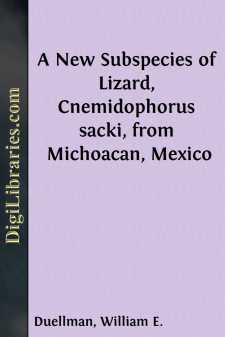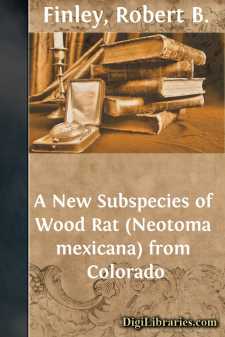Fiction
- Action & Adventure 180
- Biographical 15
- Christian 59
- Classics
- Coming of Age 5
- Contemporary Women 3
- Erotica 8
- Espionage/Intrigue 12
- Fairy Tales, Folklore & Mythology 236
- Family Life 169
- Fantasy 117
- Gay 1
- General 596
- Ghost 32
- Historical 808
- Horror 43
- Humorous 160
- Jewish 25
- Legal 4
- Medical 22
- Mystery & Detective 315
- Political 49
- Psychological 41
- Religious 64
- Romance 159
- Sagas 11
- Science Fiction 730
- Sea Stories 113
- Short Stories (single author) 537
- Sports 10
- Suspense 1
- Technological 8
- Thrillers 2
- Urban Life 31
- Visionary & Metaphysical 1
- War & Military 173
- Westerns 199
Classics Books
Sort by:
In studying the kinds of mammals known from Kansas, I had occasion to examine a series of Perognathus flavus from the western part of the state. Comparisons of these specimens with topotypes of named subspecies revealed that the specimens from Kansas belong to a heretofore undescribed subspecies which ranges through western Nebraska, eastern Colorado, western Kansas, and western Oklahoma. This...
more...
by:
John M. Legler
In July, 1957, members of a field party from the University of Kansas Museum of Natural History, under the direction of Mr. Sydney Anderson, spent 12 days collecting vertebrates in the vicinity of Creel in southwestern Chihuahua. Among the specimens are two snakes representing an undescribed species of the genus Geophis. A description and illustrations of these two specimens were prepared and submitted...
more...
by:
Robert G. Webb
Thirteen specimens of frogs collected in the summers of 1960 and 1961 in the Mexican states of Durango and Sinaloa represent a heretofore unnamed species. The specimens have been deposited in the Museum of Natural History of the University of Kansas (KU) and in the Museum of Michigan State University (MSU). The species may be named and described as follows: Tomodactylus saxatilis new species...
more...
Heretofore our knowledge of the osteology of Heliscomys Cope has been extremely limited; this genus previously was known by its teeth, fragmental maxillaries, incomplete palatine bone and mandible, and part of one forelimb. In the summer of 1946 the writer, as a member of the University of Kansas Museum of Natural History field party, discovered the anterior part of a skull of Heliscomys in the middle...
more...
J. R. Alcorn collected a number of pocket gophers of the genus Pappogeomys in the states of Jalisco, Nayarit, and Colima. The bulk of this material was obtained in 1949 and 1950. Full treatment of these interesting pocket gophers will be given by the author in a future publication. Among the Pappogeomys collected by Alcorn were three specimens from the high Sierra del Tigre, an isolated range not...
more...
by:
Terry A. Vaughan
The first specimens of Myotis velifer from California were taken in 1909 by C. L. Camp at Needles, San Bernardino County (Grinnell, Univ. California Publ. Zool., 12:266, March 20, 1914), and subsequently this bat was recorded from farther south in the lower Colorado River Valley at the Riverside Mountains, Riverside County (Stager, Jour. Mamm., 20:226, May 14, 1939). West of the Rocky Mountains the...
more...
Top of head and nape dusty brown; tip of rostral and lateral edges of superciliaries dark cream-color; upper labials and sides of head anterior to eyes cream-color, mottled with blue; lower labials and postocular region pale blue; mental, postmental, and sublabials cream-color. Upper surfaces of forelimbs dull bluish gray, spotted with pale greenish yellow; dorsal surfaces of proximal one-fourth of...
more...
When preparing distribution maps for a revised list of the Mammals of Kansas it became apparent to me that pocket mice of the species Perognathus flavescens from south-central Kansas and adjoining parts of Oklahoma were without a subspecific name. The new subspecies is named and described below. Perognathus flavescens cockrumi new subspecies Holotype.—Female, subadult (P4 moderately worn), skin with...
more...
by:
J. Knox Jones
The fruit-eating bats of the genus Sturnira are represented on the North American mainland by two species, S. lilium and S. ludovici. The former, in most areas the smaller of the two, is widely distributed in México and Central America and is common in many places. On the other hand, S. ludovici, described by Anthony (1924:8) from near Gualea, Ecuador, generally has been regarded as rare; insofar as...
more...
by:
Robert B. Finley
Field and museum studies of the wood rats of Colorado have revealed the existence of an unnamed subspecies of Neotoma mexicana in eastern Colorado south of the Arkansas River. The characters of the new subspecies are most distinctive in the northeastern part of its range near Two Buttes and Higbee. It differs in cranial characters from N. m. fallax and N. m. inopinata and averages slightly larger, but...
more...




